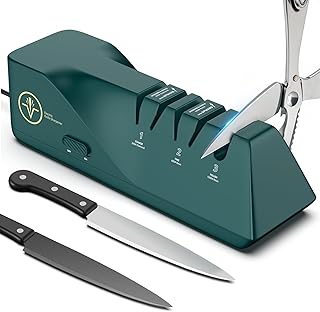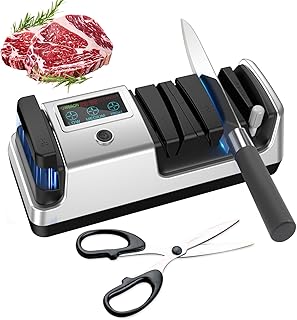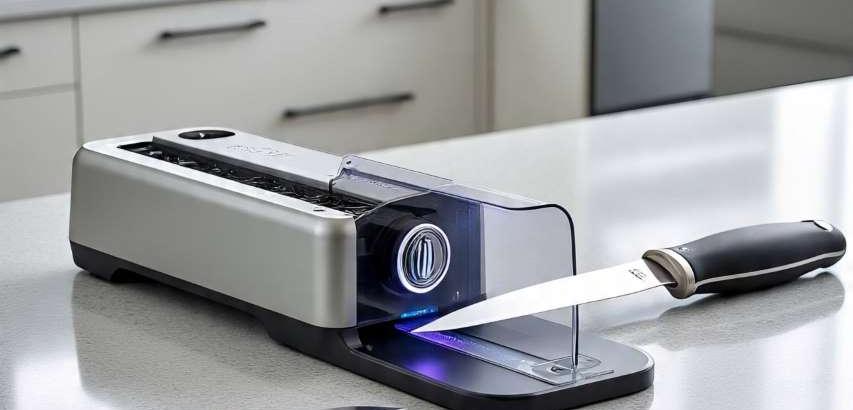An electric knife sharpener is a countertop appliance that uses motorized abrasive wheels (usually made of diamond, tungsten carbide, or ceramic) to quickly grind a new, sharp edge onto dull knives. It is designed for convenience and ease of use, requiring minimal skill compared to manual sharpening methods.
How It Works: The Multi-Stage Process
Most electric sharpeners use a guided, multi-stage system:
Stage 1: Coarse Grinding / Repair
Abrasive: Rough diamond or tungsten carbide wheels.
Function: Reshapes the edge, removes nicks, and repairs significant damage. This stage is for very dull or damaged knives.
Stage 2: Fine Sharpening / Honing
Abrasive: Finer ceramic or diamond wheels.
Function: Sharpens the edge created in Stage 1, refining it to a keen finish.
Stage 3: Polishing / Stropping (on premium models)
Abrasive: Ultra-fine ceramic or leather stropping wheels.
Function: Polishes the edge, removing any microscopic burrs for a razor-sharp, refined finish that lasts longer.
The Process: The user simply pulls the knife through the appropriate slot(s) a few times. The guides ensure the correct sharpening angle is maintained consistently.
Types of Electric Knife Sharpeners
Type | Description | Best For |
|---|---|---|
| Multi-Stage Pull-Through | The most common type. Features 2 or 3 slots for coarse, fine, and polishing. | Most home cooks. Excellent for standard kitchen knives (chef's, paring, serrated). |
| Precision Manual Guided | A motorized unit where the knife is clamped into a guide that moves across a spinning sharpening wheel. | Enthusiasts and professionals. Offers more control over the angle and is better for high-end knives. |
| Belt Sharpeners | Uses a continuous abrasive belt. Powerful and fast, but requires significant skill. | Professionals, butchers. Can be too aggressive for everyday kitchen knives if misused. |
Key Features & Components
Feature/Component | Description | Why It Matters |
|---|---|---|
| Abrasive Material | Diamond, Tungsten Carbide, Ceramic. | Diamond/Tungsten: Best for repair and sharpening. Ceramic: Excellent for fine honing and polishing. |
| Number of Stages | Typically 2 or 3 stages. | 2-Stage: Good for maintenance. 3-Stage: Superior for achieving a razor-sharp, polished edge. |
| Angle Guides | Slots that hold the knife at the preset optimal angle (usually between 15° and 25°). | Ensures consistency and eliminates guesswork. Crucial for beginners. |
| Magnetic Guides | Some models use magnets to gently hold the knife in place during sharpening. | Reduces friction and wear on the knife's edge during the process. |
| Serrated Knife Slot | A dedicated slot with a single abrasive rod for sharpening serrated blades. | Essential if you have serrated bread knives. |
| Vacuum Base | A suction cup base to prevent the unit from sliding on the counter during use. | A very useful safety and stability feature. |
Pros vs. Cons
✅ Advantages (Pros)
Extremely Easy to Use: No skill required. The guided slots do all the work.
Speed & Efficiency: Can sharpen a very dull knife to a usable edge in under a minute.
Consistency: Maintains the exact same angle on both sides of the blade every time.
Versatility: Most models can handle a wide variety of kitchen knives, including serrated ones.
Durability: The abrasive wheels are long-lasting and often replaceable.
❌ Limitations (Cons)
Metal Removal: More abrasive than manual methods, removing more metal from the blade over time, which can shorten the knife's lifespan.
Less Control: You cannot customize the sharpening angle, which may not be ideal for some high-end Japanese knives with specific bevels.
Noise: The motor and grinding process can be loud.
Cost: Higher upfront cost than a simple sharpening steel or pull-through manual sharpener.
Potential for Damage: Incorrect use (e.g., wrong slot, too much pressure) can damage the knife.
Top Use Cases & Applications
The Busy Home Cook: Perfect for anyone who wants sharp knives without the learning curve of stones.
Maintaining Daily Drivers: Ideal for frequently used German-style knives (Wüsthof, Henckels) which have durable, softer steel.
Quick Kitchen Rescue: Quickly fixes knives that have become too dull to slice a tomato.
Serrated Knives: One of the easiest and most effective ways to sharpen serrated blades.
How to Use It Effectively & Safely
Read the Manual: Instructions vary by model. Always check first.
Plug In & Secure: Place the sharpener on a stable surface. Engage the vacuum base if it has one.
Start with Coarse (if needed): For a very dull knife, pull it smoothly through the Stage 1 slot 2-3 times.
Move to Fine: Pull the knife through the Stage 2 slot 2-3 times per side.
Polish (Optional): For the best edge, use the Stage 3 polishing slot 1-2 times.
Clean: Many models have a drawer to catch metal filings. Empty it after use.
Test: Carefully test the sharpness on a piece of paper or a tomato.
⚠️ Safety Tip: Always pull the knife away from you, from heel to tip. Never push the knife backward or move it sideways. Keep your fingers away from the slots.
Top Brands & What to Look For
| Brand | Known For | Price Range |
|---|---|---|
| Chef'sChoice | The industry leader. Known for precision angles (often 15° for Asian knives, 20° for European) and diamond abrasives. | $80 - $200 |
| Work Sharp | Innovative designs, including belt systems and precision guided sharpeners. | $60 - $150 |
| Presto / KitchenIQ | Reliable and affordable entry-level models. | $30 - $60 |
What to Look For:
3 Stages for the best results.
A dedicated serrated blade slot.
A vacuum base for stability.
Replaceable abrasive wheels for long-term value.
Price Range
| Tier | Price Range (USD) | What to Expect |
|---|---|---|
| Budget | $25 - $60 | Basic 2-stage models. May lack a serrated slot and vacuum base. |
| Mid-Range | $60 - $120 | The sweet spot. 3-stage, serrated slot, vacuum base. (e.g., Chef'sChoice 3-Stage). |
| Premium | $120 - $250 | Advanced features, specialized angle options, superior build quality. |
An electric knife sharpener is the ultimate tool for convenience and speed. It's perfect for the home cook who values sharp knives but doesn't have the time or desire to learn the art of whetstone sharpening. While it may remove more metal over the lifetime of the knife, the trade-off for effortless, consistent results is well worth it for most users.
 |  |  |
 |  |  |
